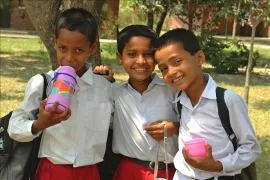Bangladesh is one of the poorest and most densely populated countries in the world. The country is affected by repeated natural disasters such as hurricanes and floods. Due to political unrest, the people of Bangladesh suffer further. Poverty is widespread and the number of abandoned children is high.
.
Some facts about Bangladesh
The People's Republic of Bangladesh is in Southern Asia, and has borders with India in the west, north and east, Myanmar in the south east, and the Bay of Bengal in the south. Bangladesh is one of the ten most heavily populated countries in the world with 159 million people (July 2011 est.). The capital city of Dhaka is home to around 12 million, thus making it one of the ten most populated cities in the world.
After years of political unrest, the present day Republic of Bangladesh came into existence in 1971.
Independence was achieved after a war with Pakistan which left over three million dead. The political climate following independence was unstable, but after 15 years of military rule, democracy was restored in 1990. However, the country still suffers from a volatile political climate.
It is not only the political climate which is unstable: the country is frequently affected by natural disasters such as heavy rainfall or cyclones that cause damage to infrastructure, crops and livestock. About a third of the country floods annually during the monsoon season.
An economy damaged by political upheavals and natural disasters
The combination of political upheavals and natural disasters has affected the country's economic development. However, the economy has developed quickly and grown at an average rate of five per cent per year since 1996.
Despite the progress, Bangladesh remains one of the world's poorest countries. It is estimated that about half of the population lives on less than one US dollar a day, and over 80 per cent of the population on less than two dollars a day.
Most people work in agriculture, producing mainly jute and rice. The country is trying to build up the service and industry sectors. Although the official unemployment rate of 4.80 per cent (2011 est.) is not alarmingly high, about 40 per cent of the population is underemployed.
The quality of, and access to, health care and education varies. Infant, maternal and under-five mortality rates have improved but only for some sectors of the population in limited geographical areas. Only 80 per cent of the population has access to improved drinking water and just over half to improved sanitation facilities.
Although basic free education is provided for children between the ages of six and ten years, Bangladesh continues to have one of the lowest levels of literacy in the world - around 48 per cent of the population are unable to read.
The low standard of living and the precarious environmental and economic situation, leave people particularly susceptible to the false promises of human traffickers. Bangladesh is a source and transit country for men, women and children who end up in conditions of forced lab our or being sexually exploited.
Situation of the children in Bangladesh
Demographically speaking, Bangladesh is a very young country where over 60 million people under the age of 18 live. Children are particularly affected by the general poverty levels and it is calculated that one in ten suffer from malnutrition.
Although no reliable figures exist, local experts estimate that about a third of all children do not have parental care or are at risk of losing it. Children who are at risk of losing parental care include those who are born to single mothers, or live with dislocated families in slum housing.
Although children under the age of 14 are banned by law from working, an estimated five million children between the ages of 5 and 14 are involved in child lab our. Many of these work in exploitative conditions or in high risk jobs. In rural areas, children mostly lab our in agriculture. As families migrate to cities in search of work, children end up living either in overcrowded squatter settlements or on the streets. They are forced to work as domestic workers, touting goods or in shops. As the children do not have the time to attend regular schooling, they end up in the vicious cycle of inter generational poverty.



